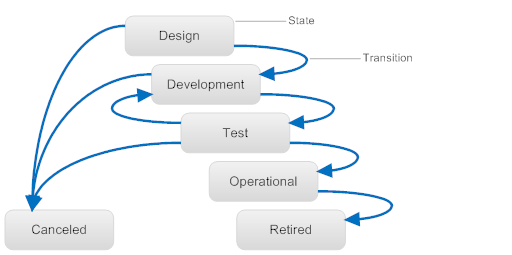Lifecycle Model States and Transitions
A lifecycle model is composed of states and transitions.
A state represents a distinct step through which an asset passes on its way from conception to retirement. A very simple lifecycle model for an asset might include states such as Design, Development, Test, Operational and Retired. It might also include the Canceled state for assets whose lifecycle is terminated prior to completion.
A transition represents the act of switching an asset from one state to another. When you define a lifecycle model, you specify both the states that make up the lifecycle and the transitions that can occur from each state. For example, the Test state might have possible transitions to the Operational, Development and Canceled states. If these are the only three transitions that you define for the Test state, these are the only states to which CentraSite will allow an asset in the Test state to be switched.
Figure 5. Lifecycle models are composed of states and transitions
A lifecycle model must have one initial state. Assets to which the model is applied enter the initial state when they are first added to the registry. Every state except the initial state must have at least one inbound transition associated with it.
A lifecycle model must have at least one end state. An end state has no outbound transitions associated with it. The lifecycle model depicted in the figure above, for example, has two end states: Canceled and Retired.

